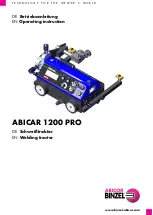
4
1 Safety Precautions
1.1.
GENERAL GUIDELINES
1. When servicing, observe the original lead dress. If a short circuit is found, replace all parts which have been overheated or
damaged by the short circuit.
2. After servicing, see to it that all the protective devices such as insulation barriers, insulation papers shields are properly
installed.
3. After servicing, carry out the following leakage current checks to prevent the customer from being exposed to shock hazards.
1.1.1.
LEAKAGE CURRENT COLD CHECK
1. Unplug the AC cord and connect a jumper between the two prongs on the plug.
2. Measure the resistance value, with an ohmmeter, between the jumpered AC plug and each exposed metallic cabinet part on
the equipment such as screwheads, connectors, control shafts, etc. When the exposed metallic part has a return path to the
chassis, the reading should be between 1M
and 5.2M
.
When the exposed metal does not have a return path to the chassis, the reading must be
(This “Safety Precaution” is applied only in U.S.A.)
1. Before servicing, unplug the power cord to prevent an electric shock.
2. When replacing parts, use only manufacturer’s recommended components for safety.
3. Check the condition of the power cord. Replace if wear or damage is evident.
4. After servicing, be sure to restore the lead dress, insulation barriers, insulation papers, shields, etc.
5. Before returning the serviced equipment to the customer, be sure to make the following insulation resistance test to prevent
the customer from being exposed to a shock hazard.
1.1.2.
LEAKAGE CURRENT HOT CHECK
1. Plug the AC cord directly into the AC outlet. Do not use an isolation transformer for this check.
2. Connect a 1.5k
, 10 watts resistor, in parallel with a 0.15
F capacitors, between each exposed metallic part on the set and a
good earth ground such as a water pipe, as shown in Figure 1.
3. Use an AC voltmeter, with 1000 ohms/volt or more sensitivity, to measure the potential across the resistor.
4. Check each exposed metallic part, and measure the voltage at each point.
5. Reverse the AC plug in the AC outlet and repeat each of the above measurements.
6. The potential at any point should not exceed 0.75 volts RMS. A leakage current tester (Simpson Model 229 or equivalent)
may be used to make the hot checks, leakage current must not exceed 1/2 milliamp. In case a measurement is outside of the
limits specified, there is a possibility of a shock hazard, and the equipment should be repaired and rechecked before it is
returned to the customer.
Figure 1
1.2.
Before Repair and Adjustment
Disconnect AC power to discharge unit AC Capacitors as such (C5700, C5701, C5702, C5703, C5705, C5706) through a 10
, 10
W resistor to ground.
Caution:
DO NOT SHORT-CIRCUIT DIRECTLY (with a screwdriver blade, for instance), as this may destroy solid state devices.
After repairs are completed, restore power gradually using a variac, to avoid overcurrent.
Current consumption at AC 120 V, 60 Hz in NO SIGNAL mode volume minimal should be ~ 900 mA.
Summary of Contents for SA-BT230P
Page 14: ...14 ...
Page 15: ...15 5 Location of Controls and Components 5 1 Remote Control Key Button Operations ...
Page 16: ...16 5 2 Main Unit Key Button Operations ...
Page 17: ...17 5 3 Using BD LIVE BONUSVIEW in BD Video ...
Page 18: ...18 5 4 Using the iPod iPhone ...
Page 19: ...19 5 4 1 iPod iPhone Playback ...
Page 20: ...20 5 5 Speaker Connections ...
Page 21: ...21 5 6 Disc Playability ...
Page 22: ...22 5 7 SD Information ...
Page 23: ...23 5 8 File Extension Type Support MP3 JPEG AVCHD MPEG2 files ...
Page 24: ...24 5 8 1 File Folders Structures ...
Page 38: ...38 8 1 3 Main P C B Fig 3 Main P C B IC2302 LB2301 CN2004 ...
Page 42: ...42 10 2 Main Components and P C B Locations ...
Page 62: ...62 10 16 6 Applying Grease ...
Page 63: ...63 10 16 7 Cleansing the Lens of Optical Pick UP Follow the 10 27 1 Upper Base Ass y ...
Page 94: ...94 ...
Page 102: ...102 ...
Page 104: ...104 ...
Page 128: ...128 ...
Page 130: ...130 ...
Page 132: ...132 20 1 2 Mechanism BD Drive ...





































